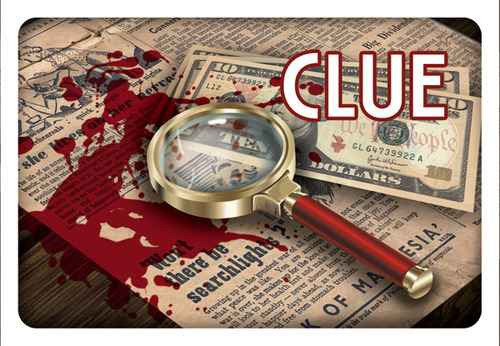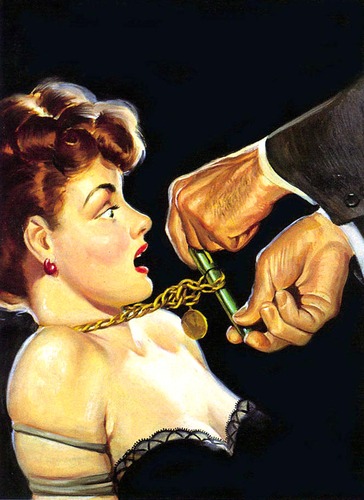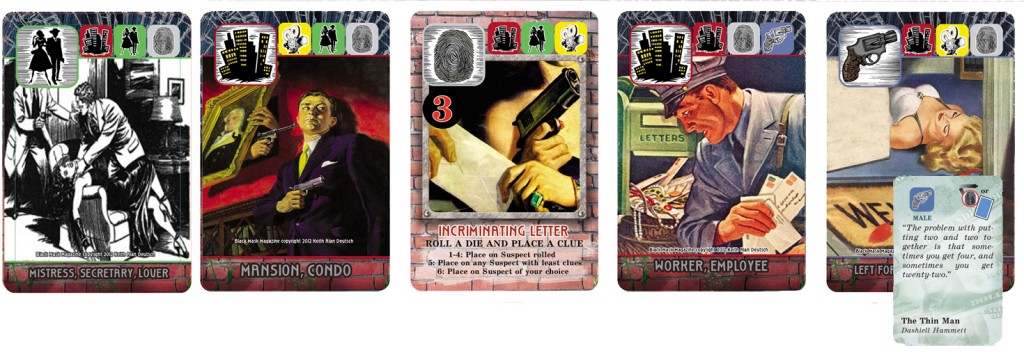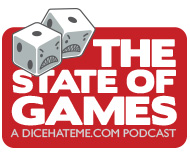Just the Facts: Richard Launius Spills About Ace Detective
All of you dear readers are probably familiar with my zest for zeppelins and my love of all things Lovecraft, but I also have another vice – pulp, gritty noir, and the darker the better. Luckily for me, my favorite purveyor of prized Lovecraftian gameplay, Richard Launius, has thrown a touch of Howard Philips in with a truckload of pulp private investigators in Ace Detective, currently on Kickstarter. Curious to know more – and knowing quite a few of you would be, as well – Richard was gracious enough to give us some clues about his newest caper.
————
 Dice Hate Me: So, Ace Detective is a storytelling game, set in the world of 1940s pulp noir. The gameplay seems a bit more subjective than most of your other designs, and there is only one six-sided die in the game. How did Ace Detective develop? How was it born?
Dice Hate Me: So, Ace Detective is a storytelling game, set in the world of 1940s pulp noir. The gameplay seems a bit more subjective than most of your other designs, and there is only one six-sided die in the game. How did Ace Detective develop? How was it born?
Richard Launius: The idea for Ace Detective came to me a few years after I had completed the original design of Arkham Horror. I had been reading several Dashiell Hammett stories and had always liked the gritty detective stuff. Additionally, my children were young at the time and we always played a story telling game when traveling, one where I would start a story and then have them interject the next key event and then I would add that to the story. It was fun for everyone, and something in the age of smart phones and hand held electronic games to fondly remember simpler times. While most of those family travel stories were fairy-tale in nature “The knight wandering through a dark forest came upon” and one of the kids would add Giant Frog, and “a giant frog singing a song and playing a harp.” – you get the idea. Thinking about these travel tales prompted the idea for a game in which the players used cards to craft a story collectively, and the gritty, noir detective mysteries that I liked seemed to be the perfect setting. Thus, the first rendition of Ace Detective was created.
 DHM: Although some gamers may often forget, Arkham Horror is a bit of a storytelling game, as well. How similar was the development of Ace Detective with the revised Arkham Horror from Fantasy Flight?
DHM: Although some gamers may often forget, Arkham Horror is a bit of a storytelling game, as well. How similar was the development of Ace Detective with the revised Arkham Horror from Fantasy Flight?
Richard: Arkham Horror and Ace Detective have almost nothing in common, other than they are both dripping with theme. In Arkham Horror, the storytelling is done by the game; each encounter card, the history of each character, and the headline of each Mythos card so that it is the game that provides the storytelling. In Ace Detective the storytelling is created by the players, and therefore the more creative they are the more enjoyable the game play. Although the game can be played at a lesser storytelling level (the Hardboiled Detective Game), the game is most enjoyable when playing the full storytelling game (the Pulp Fiction Tales Game) where players rate each addition to the story and the teller (as well as the raters) gaining Plot Points based upon several storytelling factors to move the mystery story forward. Each player turn the player will play 1 or more cards onto the story line by using a key word on one of their cards to craft a few sentences, up to a paragraph, when played. So, the game has very few similarities to Arkham Horror other than both are very thematic.
DHM: Do you think fans of Arkham Horror would enjoy Ace Detective?
Richard: I think a lot of the players of Arkham Horror will like Ace Detective because many are well-read in pulp fiction and enjoy the gritty world of the noir detective. Those that like to create, write stories, and especially players with active imaginations will find Ace Detective a fun catalyst to create noir stories with their friends (and with the Strange Tales expansion – even Lovecraftian Stories). While Ace Detective is not for everyone, and I am sure that will include a lot of Arkham Horror players, it is a game that many creative players will enjoy for the same reason that they enjoy Arkham Horror, because they will have a different and memorable story emerge from every game.
 DHM: What is your favorite game mechanic from Ace Detective – the one in which you’re most proud?
DHM: What is your favorite game mechanic from Ace Detective – the one in which you’re most proud?
Richard: I would say it is a tossup between 1) the Rating mechanic (which was much more difficult to create than one would suspect because it has to remove as much “gaming aspect” from the non-storytelling players as possible) to ensure great storytelling is rewarded, and 2) the Clue resolution process that Jason Maxwell and I worked on together. One of the things that is important with a storytelling game is that the mechanics should not deter from the actual process of storytelling, but rather support it in a streamlined and efficient way. Also, for players that really want to have some tension, deduction, and a core game play beyond the storytelling aspect, the Clue resolution mechanics deliver.
 DHM: What were some of the classic noir influences in the game? Any particular favorite books or movies that helped you refine the storytelling aspects – and that you’d recommend to players wanting to delve further into that world?
DHM: What were some of the classic noir influences in the game? Any particular favorite books or movies that helped you refine the storytelling aspects – and that you’d recommend to players wanting to delve further into that world?
Already answered for the most part – but books and movies from Dashiell Hammett and Raymond Chandler. Also, I really liked the 1982 Movie Hammett that was a fictional story where Dashiell Hammett (played by Frederick Forrest) was the hero in his own mystery. I would recommend The Maltese Falcon and The Dain Curse from Hammett,and from Chandler my favorite is The Big Sleep. I highly recommend them to anyone that enjoys gritty detective tales.
DHM: The artwork in the game is classic pulp artwork from Black Mask Magazine, which I, and many others, absolutely love. However, it has not been without a bit of controversy. There may have been some minor censoring of some images on Boardgamegeek and not a small amount of discussion of their somewhat-violent imagery. What is your take on this? Can you share any back story on how the art came to be used in Ace Detective?

(8th Summit Games founder Jason Maxwell stepped in to answer this question) Jason Maxwell: I was mistaken that BGG did any censoring. The day I posted the images I got a couple of emails from concerned buyers of the game. I think more than anything they wanted to be assured that we were not condoning the type of violence that the images evoked – and they understood we did not create the images. That same day I also noticed the images were not moving up the ranks, so I thought maybe BGG had a problem with them as well. Maybe they received a complaint? I wasn’t sure. But it seems I jumped the gun. I had just miscategorized them.
There has been some minor concern expressed in the forums. Gamers are above average intelligence. They understand the relevance and nature of the work – but still they felt the need to express their concerns – and I understand completely. But I think that is part of the charm of the artwork in this game. It takes you into another place and another time – when both fictional and everyday life was different. This was once pop culture and informs our pop culture today, even if some of the images are provocative.
DHM: Can you tell us more about the expansion – Strange Tales?
Richard: The Strange Tales expansion kind of took on a life of its own in development. When the idea was first posed to me by Jason I thought that this could be a nice little addition to the game to tell a gothic horror or Lovecraftian story for players that prefer that type of tale. In design, the ideas kept flowing and the Strange Tales expansion grew to be much more than adding new thematic cards. The Clue mechanic expanded and special tokens were added that provide a huge bonus to the player playing them if they properly identify the secret of a Suspect (perhaps they are an Alien Pod Person, a Vampire, a Werewolf, a young Deep One, or a Witch) and place the right Clue token on the Suspect (Like the Elder Sign on the Deep One, or the Flying Saucer on the Pod Person). The Secrets are cool, and the expanded Clue play interesting. The game becomes more versatile to the player’s imaginations with this game since it opens the entire pulp Sci-fi and horror world. Additionally, this expansion introduces a new type of card as well – the Item. Item cards are few, but once added to the story line they remain active and be used more than one time while telling the story (after all if you use that Time Machine to go into the future you also need to be able to return). It should be noted that when the Strange Tales expansion is used, an equal amount (and type) of cards from the original noir detective game are randomly removed, so the game does feel much different in theme from the base game of detective noir even though many of the base game cards remain in play.
Even though the Strange tales expansion is fun and creates a story that many players will enjoy, I suspect many (like me) will switch back and forth between the original gritty, noir detective tales and the bizarre and horrific pulp stories that Strange Tales can help them to weave. I think it is a really nice edition and a great expansion that can only be obtained in the Kickstarter deal.
DHM: Ace Detective has already surpassed its funding goal and is nearing the first stretch reward – a set of Lovecraft narration cards. Other than the stretch goals and Strange Tales expansion, do you have other expansion ideas for Ace Detective in the works?
Richard: While I think the game has potential for more cards (base set and Strange Tales) there are no plans at present to expand. Still, opportunities are as vast as the imagination.
DHM: Will you be collaborating with 8th Summit Games on any other projects in the near future?
Richard: Yes, Jason Maxwell is a friend and as such knows about most of the designs I have on my the shelves of my office. One day he came over and started fishing through the bookshelves looking for story telling games, as he has a real desire to expand his publishing of that type of game. He had already played Ace Detective and was looking for it specifically, but also became very interested in 8th Summit publishing another of my storytelling game designs: Mythos Tales, a Lovecraftian game in which one player represents the forces of the Outer Gods and the cultists, and the other player represents the intrepid investigators working through a specific story. The game is played with the players battling over the key plot events of each chapter (most game stories have 3 chapters where the story unfolds based on the success of the players on each plot), and players score points and read from their specific storybook as plot cards are achieved. It is a fun (and I think very unique) game whereby each player has their own specific deck of cards that they use to resolve the story being played. Each player also has their own specific booklet containing the stories that are read from as the plots of the story are resolved. The story will change depending on which side won the Plot, determining which book the key paragraph and new rewards and/or conditions will be triggered (for example, when the Investigator player wins the Ancient Tome plot, the tale in their book – and the rewards/conditions triggered- is very different from the tale that would be read if the Cultist player had gained the Tome). At present the game comes with 6 very different stories, associated Story Plot Cards, an Investigator Deck, a Cultist Deck,a Special Conditions Deck (over 50 Special Conditions prompted by the stories), and 2 miniatures (a Cultist and Investigator Sculpts) to track points, tokens, and 5 Custom Icon Dice. I think it is a novel storytelling game that a lot of players should enjoy.
For more information on Ace Detective – and to pledge your support – please check out the official Kickstarter campaign page.
Related posts:
- The State of Games, Episode 15 – The One About Richard Launius
- The State of Games, Episode 30 – The One About the Duke of Dice
- The State of Games, Episode 10 – The One About Origins
- The State of Games, Episode 23 – The One About the Unpublished Masses
- The State of Games, Episode 31 – The One About Origins, Chemistry and The Big Blue Noodle


